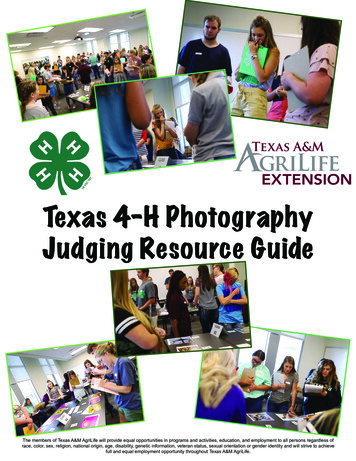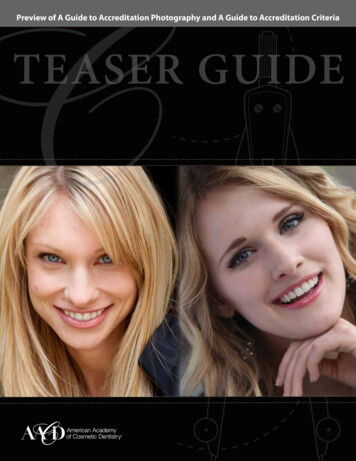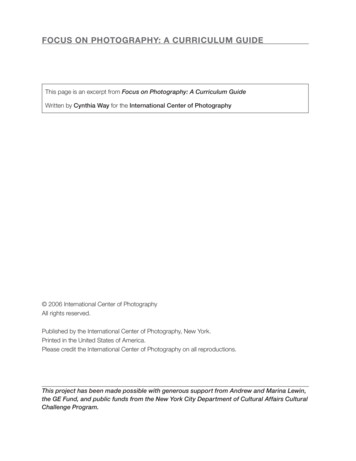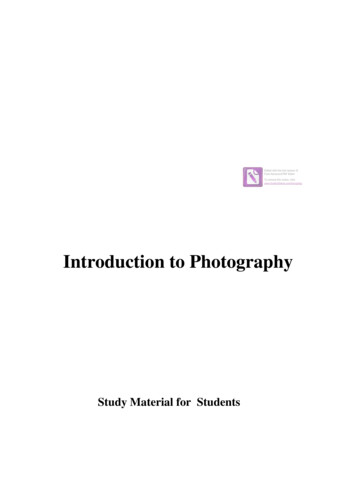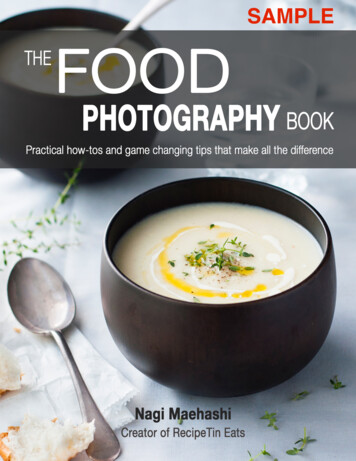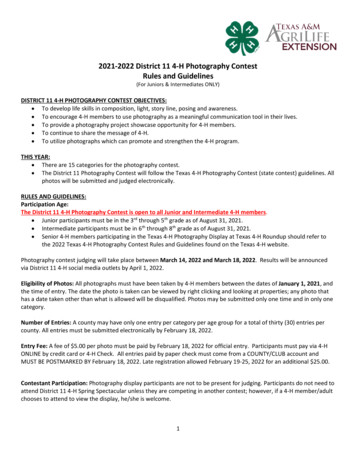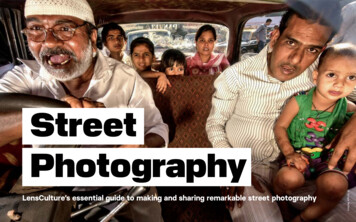
Transcription
01. Take it to the streets02. Share your streets03. InspirationP1 Dougie WallaceLensCulture’s essential guide to making and sharing remarkable street photographyLensCulture Street Photography Guide 2019StreetPhotography
IntroductionFor those who love the classics, HenriCartier-Bresson’s romantic black and whitephotographs might flash before your eyes.For others, your favourite account or hashtagon Instagram might be your first referencepoint — a symbol of the genre’s explosivepopularity in recent years.P2In both aesthetic and approach, streetphotography has expanded and evolved somuch that it can be difficult to find a singulardefinition for all of the street-based imagesbeing made around the world today.In this guide, we embrace this diversity withopen arms. Our aim is to highlight the manypossibilities of street photography while givingyou the tools and inspiration to harness your ownunique perspective from the streets, whereveryou are and however you define them.Inside these pages, you’ll find interviews andrecommendations from top street photographers,editors and curators. Get to know some of thegreats of the genre alongside new voices usingstreet photography as a process. Thank you fordownloading and enjoy!LensCulture Street Photography Guide 2019What comes to mindwhen you think of streetphotography?
IntroductionP3LensCulture Portrait Guide 2019 Frank MultariConsider this a companion for allyour future street meanderings.It’s not so much a how-to,but a thought-starter fromLensCulture to our community ofphotographers and photographylovers around the world.
Table of Contents02.SHARE YOUR STREETS03.INSPIRATION8Street photography as a process:Essay by Serge J-F. Levy33Submit your work: Competitionsand Festivals6114In search of poets and new masters:Interview with photo editor OlivierLaurent35Feedback, workshops and reviews:The key to growth and connectionsPhotographs from theperiphery: Thoughts on VivianMaier by curator Anne Morin66Project Spotlight78Book recommendations81Film recommendations83Instagram Spotlight20P427Street manipulations: Interviewwith photographer Esther HoversTime, patience and repetition:Interview with photographerMatt Stuart404853Embrace the darkness: Interviewwith photographer Arko DattoKnow your why: Interview withpublisher Dewi LewisShining a light on absurd moments:Interview with photographer Feng LiLensCulture Street Photography Guide 201901.TAKE IT TO THE STREETS
“ The secret to compellingLEKGETHO MAKOLAP5Director of Market Photo Workshop2019 Street Awards JurorLensCulture Portrait Guide 2019street photographs isethical acknowledgementof the social dynamicsof the spaces beingphotographed.”
01.TAKE ITTOTHESTREETS Tatsuo Suzuki
01. Take it to the streets02. Share your streets03. InspirationStreet photography is varied in how it looks and how it’smade, but there are still common elements that threadthrough the work of all the greats, from well-known mastersto today’s contemporary practitioners. It all boils down to alove for the unexpected, candid moments of life, an ability tofind some order within the joyous chaos of the world, and anunparalleled creative vision.P7In this chapter, we explore different approaches to makingremarkable street photography. If you want to make imagesthat deftly combine composition, light and content to reflectthe world in a way we haven’t seen before, read on.LensCulture Street Photography Guide 2019Put on your walkingshoes, we’re hittingthe streets!
01. Take it to the streets02. Share your streets03. InspirationAN ESSAY BYPHOTOGRAPHERAND EDUCATORSERGE J-F. LEVYLos Angeles, 2013 Ola BillmontP8LensCulture Street Photography Guide 2019StreetPhotographyAs A Process
01. Take it to the streets02. Share your streets03. InspirationOver the past 20 years, I have been creating, teaching andlooking at street photography. In that time, I have becomeincreasingly interested in enriching the definitions andlanguage that we use around this tradition. My goal is toextend the scope of the genre beyond its title (the streets,most often urban) and beyond its traditional content —often people and sometimes domestic animals (dogs,and more rarely, cats).P9Street photography is a way of walking through a spacewhile being constantly aware of how one can arrange andframe compositional elements in advance of a yet-to-beseen sequence of events that may or may not happen. Forexample, when seeking images out, some photographersprefer the shady side of the street, walking along a curbto utilize the vanishing perspective lines of the sidewalkas they merge with adjacent buildings.Paris, France, 1967 Joel MeyerowitzEssay by Serge J-F. Levy - LensCulture Street Photography Guide 2019Street photography is bothbeloved and poorly defined—this essay offers a consideredlook at what truly sets thisgenre apart.
01. Take it to the streets02. Share your streets03. InspirationP10Some argue that street photography can only happen inpublic spaces, but because street photography is a process,it can happen anywhere: in the subway, at a politicalconvention, at a private party, in the bedroom, and ofcourse, in the streets.Loop Between Woman and Dog, 1976 Mark CohenStreet photographs often contain a narrative, and whencollected together, they can define cultures or places. Yetthey aren’t beholden to a greater narrative structure. Thestreet photograph has no duty to serve a larger whole. Whilea street photograph may resonate with other images withinthe context of a body of work, fundamentally it can existon its own. This is what sets street photography apart fromdocumentary photography.Essay by Serge J-F. Levy - LensCulture Street Photography Guide 2019Street photography is about being open to the endlesspossibility of what might make an interesting photograph:arguing couples, balletic pedestrian movement, or uncannyand witty juxtapositions of seemingly unrelated subjectmatter. Street photography is also about spontaneity: thechoreography of synchronizing an impulsive emotional orcerebral response that may transpire over the course of themilliseconds it takes to make a photographic exposure.
01. Take it to the streets02. Share your streets03. InspirationP11Many street photographers curate their own work inretrospect, only realizing the development of themesthroughout their process later on. In this case, the act ofreflecting upon one’s own work (or with the assistance ofan astute observer) reveals one of the greatest rewards forworking so spontaneously: the unconscious concerns ofthe photographer become revealed through an instinctiveapproach to making pictures.Weymouth, 2006 Paul RussellMy definition of street photography knocks out someof the most familiar street photography from beingrecognized as such. Garry Winogrand created a series ofphotographs exhibited under the title of “Public Relations.”Many of the images were made at dinners, dances, pressconferences and other indoor venues—and in the streets.He approached this work with the intention of portraying“the effect of media on events.” However, for me, many ofthe “Public Relations” images extend beyond fulfilling hisinitial narrative and branching out into what makes GarryWinogrand’s photographs so uniquely strong: their ability todefy a singular reading or purpose and feel so spontaneouslyspot-on.Essay by Serge J-F. Levy - LensCulture Street Photography Guide 2019Another distinguishing aspect is that the streetphotographer, as opposed to the still life or landscapephotographer, approaches each instant tabula rasa withouta prescribed narrative or intention. When the intention ofthe photographer becomes more defined, and he or shebegins to seek a type of image or specific subject matter,their work begins to step out of the street photographygenre and moves towards a transformation into adocumentary project.
01. Take it to the streets02. Share your streets03. InspirationGenres are useful, but they also limit the possibilities of howa photograph can be approached and experienced by anaudience. To me, Diane Arbus’ recently-uncovered photographof a newspaper stirring under a gentle breeze amidst adark and oppressive ocean of pavement is much more thana street photograph, a still life, or even a landscape—it iseverything a photograph can do that words cannot.P12—Edited from a longer essay published on LensCultureWindblown headline on a dark pavement, NYC, 1956 Diane ArbusEssay by Serge J-F. Levy - LensCulture Street Photography Guide 2019Interacting with the subject can dilute the spontaneity ofthe moment, and the photographer often seeks a type ofperson to fulfil the structure of a narrative idea. For example,Bruce Davidson’s East 100th Street work (which he wouldagree is not street photography), Robert Bergman’s A Kindof Rapture and Jamel Shabazz’s Back in the Days are threeprojects on the indistinct border between street photographyand portraiture.
01. Take it to the streets02. Share your streets03. InspirationLensCulture Street Photography Guide 2019“ I think every photographer shoulddefine what the street means tothem in their own way. There’sno one way of defining streetphotography.”CAROLYN DRAKEMagnum Photographerfrom The Art of Street PhotographyP13Carolyn Drake, Bonez at AutoZone. Vallejo, California. USA. 2016.Image Carolyn Drake/Magnum Photos
01. Take it to the streets02. Share your streets03. InspirationP14Ethipia, Harar Graciela MagnoniINTERVIEW WITH PHOTOEDITOR, OLIVIER LAURENTLensCulture Street Photography Guide 2019In Search ofPoets andNew Masters
01. Take it to the streets02. Share your streets03. InspirationP15Questions by Alexander StreckerAnswers by Olivier LaurentYou have broad and eclectic tastes when it comesto photography. What’s special about streetphotography for you?OThere’s something poetic about street photography.It’s not just about being there—it’s about imagination,it’s about seeing the future. And by that, I meanbeing able to anticipate where different elements ofa photograph—the street, the signs, the people—willalign to make the perfect picture. There are many streetphotographers out there, but the great ones are poetsand, like in any other field of photography, there are justa few of them.In recent years, some have tried to innovate—forexample, there was a craze a few years ago forGoogle Street View photographers. Their projectswere interesting, but they can’t replace the magicalserendipity of a frame coming into place right in frontof a street photographer’s lens.Bushwick, Brooklyn, 2014 Andre D. WagnerInterview with Olivier Laurent - LensCulture Street Photography Guide 2019In this interview, respectedphoto editor Olivier Laurentdiscusses the special qualitiesof great street photography,why the genre isn’t dead,and the one question allphotographers must considerwhen making work.A
01. Take it to the streets02. Share your streets03. InspirationSome say that street photography is dead, and thatits Golden Age has passed. Others proclaim it is morevibrant than ever, especially thanks to new platformsfor dissemination (Instagram principally, but Flickr andFacebook as well). Where do you fall on this spectrum?OThe “street photography is dead” refrain calls to mind the“photojournalism is dead” debate that has been ragingsince the 1950s. It’s ridiculous. Yes, there were giants ofstreet photography who left us—from Garry Winograndto Henry Cartier-Bresson, Weegee, Berenice Abbott andRobert Doisneau. And there are the established names likeRobert Frank, Joel Meyerowitz and Lee Friedlander who arestill working. But that doesn’t mean there aren’t new streetphotographers out there who are making amazing work.I was at The New York Times’ New York Portfolio Reviewlast year, and I saw the promising work of the youngAndre D. Wagner. He has the eye. He is the future.LensCulture Street Photography Guide 2019AP16Starry Night by Kin Wing Wong
01. Take it to the streets02. Share your streets03. InspirationP17Street photography is like everything else. Instagram,Flickr, Facebook, and mobile phones help create newecosystems where new voices can emerge. Of course,there are now thousands, if not hundreds of thousandsof people who think they are street photographers.But if we know where to look and, more importantly, ifwe take the time to look, we’ll find the new masters ofstreet photography.AI know you were particularly interested in mobilephotography a few years ago. Is this still a meaningfulcategory or has the distinction between mobile and“real” photography been erased?OI wish I could say it’s been completely erased, but I stillhear so many of my colleagues ask the question: “Whatcamera did you use?” This is irrelevant. Photography hasalways been about the eye. I guess you could say that amobile phone allows for a certain anonymity in the street,but I don’t ask myself that question when I look at thework of a street photographer. As I said, I look for tracesof poetry and magic in their photos.Interview with Olivier Laurent - LensCulture Street Photography Guide 2019From the series “Casablanca (Not the Movie)” Yoriyas Yassine Alaoui IsmailiO
01. Take it to the streets02. Share your streets03. InspirationWhat are a few traits you recognize in all of thephotographers you’ve published? Are there certaincommonalities among the most successful ones?OIn photojournalism, street photography, or any other genreof photography, I look for commitment and passion. I wantto know that they chose to photograph something becausethey felt strongly about it, and that it was personal to them.Too many photographers embark on projects becausethey think that’s what the industry in general, and photoeditors in particular, want to see. Maybe they’re rightsometimes, but the best projects I’ve seen always camefrom photographers who were deeply affected by andcommitted to their subjects. It’s the question I always askphotographers who I meet: Why are you doing this? Whyyou over every other photographer?P18—Excerpt of an interview by Alexander StreckerLensCulture Street Photography Guide 2019AFrom the series “I Speak of the City” Dimitri Mellos
01. Take it to the streets02. Share your streets03. InspirationMARTIN PARRMagnum Photographerfrom The Art of Street PhotographyP19Martin Parr. Westbay. England, Great Britain. 1996.Image Martin Parr/Magnum PhotosLensCulture Street Photography Guide 2019“ Most of the pictures you see, youactually miss. So inevitably, whatyou end up doing is taking a lot ofrubbish. In fact, the basic theoryis, the more rubbish you take thebetter the chances of a good photoemerging as well. So, keep on takingthe rubbish.”
01. Take it to the streets02. Share your streets03. InspirationP20Traveling Salesman, 2018 – Ongoing Esther HoversINTERVIEW WITH ESTHER HOVERSLensCulture Street Photography Guide 2019StreetManipulations
01. Take it to the streets02. Share your streets03. InspirationP21Questions by Sophie WrightAnswers by Esther HoversSYour approach to the street is quite a conceptual one.Your previous project False Positives looked at intelligentsurveillance systems that detect deviant behaviour inpublic space and the way it, often invisibly, shapes ourbehaviour. Do you call yourself a street photographer?EIn my work, it’s not necessarily about the visible structureof the street, but the invisible power structures inpublic space. It’s about the question of how architecturesomehow determines our movement and is used as anexpression of power. The street is so present in it. Itseems weird to go out of my way to not call myselfa street photographer. If street photography is a genrethat can be redefined, then why not?Image Left: Anomaly 1, Standing Still Esther Hovers Right: Anomaly 4, Placement On A Corner Esther HoversInterview with Esther Hovers - LensCulture Street Photography Guide 2019From intelligent surveillancetechnology to figuring out thebest route for our day, EstherHovers forges new visuallanguages to investigatehow our movements throughpublic space are shaped andstructured by hidden forces.
P2201. Take it to the streets02. Share your streets03. InspirationSHave you been influenced by the street genre,or any of the greats of street photography in any way?ENot so much. For me, the first person that comes to mindis Paul Graham. A Shimmer of Possibility was like mybible, and he was deeply influenced by traditional streetphotography. The title, the way he finds beauty in theselittle things, and the unpredictability of everyday lifefascinates me. And the idea of street photography andthe street itself as something going on around you, andthe way that you can play or interact with that isvery strong in the work.SWhat was your first encounter with the streetin your work? What drew you there?EA lot of it has to do with the relationship between people,body language and architecture. But in the beginning,I went about photographing it in a strictly documentaryand observational way. At school, I would go out andphotograph for my assignments in this ‘hunter’ approach,where you’re pacing around, trying to find something.I still love to do that, but it’s not so present in my workanymore.Overview E Timeframe: 0 min 04 Esther Hovers
01. Take it to the streets02. Share your streets03. InspirationP23You were working in La Défense, the business districtof Paris, when you first had the idea for False Positives.Tell me about how it started. When did you start developinga different, more conceptual approach?EI started to manipulate my images. They were based onobservation, but I began to take things out or to put thingsinto the image. I started using a tripod and a fixed frame,and then I waited for people to pass by and photographedthem. Then, I layered and stacked the images into amontage. When I did that in La Défense, it was notnecessarily with a conceptual idea behind it. It wasjust to try it out.SYou collaborate with a lot of other specialists and thinkersin your work. Can you tell me a bit about how your researchon intelligent surveillance technology shaped yourapproach to shooting?EI’m interested in the idea of not understanding thetechnology that is very important in our daily life. I want tomake it less abstract, and find a more poetic and humanway of talking about these technologies. I definitely benefitfrom looking at different fields and disciplines when visuallytranslating these connections—like the patterns in thinkingabout algorithms. The art world can be a very closed place.A lot of my references and inspirations definitely comefrom there, but it’s also a breath of fresh air to open up.Interview with Esther Hovers - LensCulture Street Photography Guide 2019Image right: Anomaly 5, Clusters Breaking Apart Esther HoversImage left: Overview H, Timeframe: 02 min 13 Esther HoversS
02. Share your streets03. InspirationSWhen you’re dealing with the more hidden relations ofpublic space, it’s important—and almost necessary—to lean on other forms of research.EYes, and we often can’t see how architecture influencesus. That seems much less technical, or much less likea power structure, but it still is.SIn False Positives, you adopted the vantage point and‘neutral’ aesthetic of a surveillance camera. It’s oftenalmost a non-human perspective that you are shootingfrom. How did the aesthetic choices for the projectdevelop?EI would start out by observing, and then I also worked withthe interface used in a lot of free intelligence software.I’d have all these neon colors as an overlay for myphotographs. Then I started approaching passersby andinteracting with them. What I liked about that is that theywere very much aware of me photographing them, whichwas important because I didn’t want to surveil them!Interview with Esther Hovers - LensCulture Street Photography Guide 2019P2401. Take it to the streetsOverview L, Timeframe: 03 min 16 Esther Hovers
01. Take it to the streets02. Share your streets03. InspirationSo it begins with observation and then builds intosomething more staged. How much happens outsideand how much happens in the studio?EBefore, I was manipulating the images. But now I amdefinitely staging them. I prepare a lot before shooting,so I’ll go and scout locations and know where I want tophotograph. But then, when I start photographing thisactor, a lot is done in the moment. The street becomesa stage.P25—Excerpt of an interview by Sophie WrightImage left: Overview A, Timeframe: 04 min 26 Esther Hovers. Right: Regular pattern of movement ‘B’ Esther Hovers.Interview with Esther Hovers - LensCulture Street Photography Guide 2019S
01. Take it to the streets02. Share your streets03. InspirationBRUCE GILDENMagnum Photographerfrom The Art of Street PhotographyP26Bruce Gilden, New York City. USA. 1984.Image Bruce Gilden/Magnum PhotosLensCulture Street Photography Guide 2019“ A good photograph is one thatworks well within the frame andhas a strong emotional content. Itemotes something in you, it makesyou have a feeling, the viewer.Whether you love it or hate it.”
01. Take it to the streets02. Share your streets03. InspirationP27INTERVIEW WITH STREETPHOTOGRAPHER MATT STUARTLondon, 2015. England, GB. Matt Stuart /Magnum PhotosLensCulture Street Photography Guide 2019Time,Patience &Repetition
01. Take it to the streets02. Share your streets03. InspirationP28Questions by Coralie KraftAnswers by Matt StuartCI’ve read in a few of your interviews that you like tofeel invisible when you shoot on the street—you preferto observe a scene quietly and then slip away beforeanyone notices you. Some photographers prefer to meettheir subjects. Why do you work the way you do?MI’m quite an extrovert, so I would be happy to confrontsubjects directly. But in fact, I find it more challengingnot to. I also prefer the process of being an observer asopposed to being part of the scene. This isn’t to say thatthe other approach isn’t valid—this is just my personalpreference. Maybe it is part of my childhood dream toone day be a spy, like a photographic 007.New Bond Street, 2006. London, England, GB. Matt Stuart / Magnum PhotosInterview with Matt Stuart - LensCulture Street Photography Guide 2019In this interview, London-basedphotographer Matt Stuartshares his approach to streetphotography, why he enjoysshooting the same placesrepeatedly, and what motivateshim to keep capturing thestreets after 20 years.
01. Take it to the streets02. Share your streets03. InspirationP29The spontaneous images you capture have elementsof humor, but they are also a real documentation ofpedestrian life in London. Do you consider yourself to bea documentarian or more of an artist? What’s your viewon the boundaries between photography and “art”?MI am really not too bothered about labels. The easy labelI have is a “street photographer,” but I’m happy to becalled whatever anyone finds convenient. My skin crawlsa bit at the word “artist,” but call me that if you want.I’ma photographer.CSome of your shots remind me of Cartier-Bresson—especially his “Children over a Fibonacci Spiral Staircase.”I know that your father gave you one of his books whenyou were first starting out. What are a few things you takeas inspiration from him that you incorporate into your ownphotographic practice?MI’m flattered by the comparison, but Cartier-Bressonwas in a completely different league. I have pawed overmany a Cartier-Bresson book and quote, but the one thatI always come back to, which keeps me going (especiallyon bad days), is: “It takes a lot of milk to make cream.”He’s absolutely right. It also reminds me that even CartierBresson had to work hard, even though he made it lookso effortless.Interview with Matt Stuart - LensCulture Street Photography Guide 2019Needham Road, 2005. London, England, GB. Matt Stuart / Magnum PhotosC
01. Take it to the streets02. Share your streets03. InspirationYou work a lot in London—a place you’ve lived for decades.Are you inspired by shooting in the same places over andover again? Is there something about the repeat visits thatis integral to your way of working?MThese days, I’m not working in London as much, althoughI do feel that a degree of repetition is helpful for trulydiscovering a wonderful place, the flow of people atdifferent times, the light and the seasons. I am nowtrying to shoot in different places. I tried Brussels, andI am starting to work more in America and other partsof England. Ever since Trump became President, I havebeen fascinated by the United States and the directionit is taking. I have long been inspired by America, but thepresent political situation has pushed some buttons for me. —Interview by Coralie KraftP30Oxford Street, 2004. London, England, GB. Matt Stuart / Magnum PhotosInterview with Matt Stuart - LensCulture Street Photography Guide 2019C
02. Share your streets03. Inspiration Bela DokaP31 Bela DokaLensCulture Street Photography Guide 201902.SHAREYOURSTREETS01. Take it to the streets
01. Take it to the streets02. Share your streets03. InspirationOur aim with this chapter is to highlight the many ways in whichyou can get your work out there in ways that feel right for you.Why? Because we believe exposure, recognition and feedback arekey to moving forward for any creative endeavour. Sharing is a thebest way to build relationships with peers, mentors, and the broaderphotography community. Sharing allows you to access differentperspectives, which may give you new ideas or cement your own.And sharing can result in a boost in confidence or an injection ofmotivation to keep going, keep creating, and keep learning.P32 Jonathan HigbeeLensCulture Street Photography Guide 2019When looking at the volume of streetphotography shared online today, it can beoverwhelming to try and discern where yourwork fits, or have the courage to share it at all.
01. Take it to the streets02. Share your streets03. InspirationCompetitionsand FestivalsAPRILJULYSony World Photography Awards Street Photography CategoryAussie Street 2019The Bangkok StreetPhotography FestivalFEBRUARYStreetFoto San Francisco International StreetPhotography AwardsStreet Week at LA Centreof PhotographyMARCHiPhone Photography AwardsLensCulture StreetPhotography AwardsItalian Street Photography FestivalMAYLuxemburg StreetPhotography FestivalStreet Photo MilanoAUGUSTLondon Street Photography FestivalOCTOBERBrussels StreetPhotography FestivalTravel Photographer of the Year Awards- Various CategoriesP33Urban Photo AwardsDECEMBERMiami Street Photography FestivalLensCulture Street Photography Guide 2019JANUARY
01. Take it to the streets02. Share your streets03.03.InspirationInspiration“ LIGHT LIKE A BIRDLensCulture Street Photography Guide 2019How you collaborate with the world may help youeventually uncover the central metaphor of a bookor project. While working on Violet Isle, the mostcommon creature I found in Cuban menageries wasthe bird. I love the complex and resonant questionsthis raises: of all the creatures, why are birds themost popular animal in Cuban menageries? Doesthis hint at some kind of longing for flight in acountry where few people are allowed to travel? Overthe years, I’ve learned that the more questions aparticular image evokes, the richer the metaphorwill ultimately be.”—REBECCA NORRIS WEBBFrom the Aperture book, Alex Webb and Rebecca Norris Webbon Street Photography and the Poetic Image2019 LensCulture Street Photography Awards JurorP34Rebecca Norris Webb
01. Take it to the streets02. Share your streets03. InspirationTHE KEY TO GROWTH,CONNECTIONS ANDFINDING YOUR VOICE Lucia HerreroP35LensCulture Street Photography Guide 2019Feedback& reviews
01. Take it to the streets02. Share your streets03. InspirationP36Portfolio ReviewsMany photography-related events and festivals offer20-minute portfolio review sessions for photographers toshow their work to influential experts in the industry and gainvaluable feedback. This is an excellent way to make in-personconnections with people who can help you in your career.Tip: Overprepare. Research the reviewers and determinewho is the best fit for your work. Know a few questionsyou want to ask each reviewer. Present your portfolioprofessionally, in a manner that is easy to carry, openand show without hassle.LensCulture Street Photography Guide 2019Hearing or reading anotherperson’s perspective onyour work can be one of thebest ways to further yourphotography, refine yourapproach, have your workseen, and connect withothers in the industry.
01. Take it to the streets02. Share your streets03. InspirationLensCulture ProfessionalReviewsP37“I definitely needed a review like this. It’s exactly what I waslooking for: a real critical, clever, and incredibly accuratereview. You’ve enlightened me about my weak points,but instead of feeling hurt, it gave me the will and theacknowledgment to work on them and improve.” Giulia ParisiReach out to other photographers and arrange a time tospecifically look at each other’s work in person or online.Many other photographers are going through similarchallenges to you. Sharing feedback and experiences withothers can help you (and them!) move past creative blocks.Tip: Not all feedback is helpful. Reach out to peopleyou respect and trust to provide honest and constructivecriticism. Be willing to show work in progress.LensCulture Street Photography Guide 2019Did you know that by entering a series of five or moresingle images in any of our awards, you can get a free writtenreview of your submitted work? This is a unique opportunityfor you to receive critical and constructive feedback on yourphotography from top photo editors, curators, publishers,gallerists, educators, critics, consultants, and other industryprofessionals.Connect with Your Community
01. Take it to the streets02. Share your streets03. InspirationOnline CoursesPrefer to learn in your own time? Check out thesetwo fantastic online learning opportunities for
LensCulture Street Photography Guide 2019 P7 01. Take it to the streets 02. Share your streets 03. Inspiration Street photography is varied in how it looks and how it’s made, but there are still common elements that thread through the work of all the greats, from well-known masters to t
